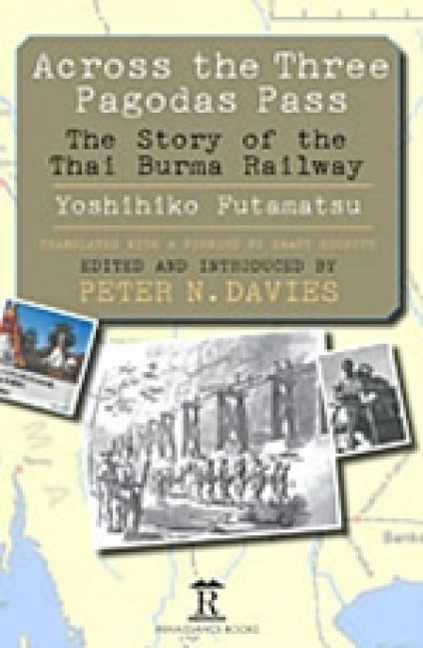Book contents
- Frontmatter
- Dedication
- Contents
- Acknowledgements
- Foreword
- Introduction
- Across the Three Pagodas Pass
- Translator’s Acknowledgements
- Preface
- Chapter 1 Departure for the Front
- Chapter 2 In Indo-China
- Chapter 3 Opening of Hostilities
- Chapter 4 The River Krian
- Chapter 5 The Malayan Campaign
- Chapter 6 The Fall of Singapore
- Chapter 7 Surrender
- Chapter 8 Shōnan: Light of the South
- Chapter 9 The Thai-Burma Railway
- Chapter 10 Preparing Construction
- Chapter 11 Banpong
- Chapter 12 Prisoners-of-War
- Chapter 13 Constructing the Railway
- Chapter 14 Thailand
- Chapter 15 The River Kwae Noi
- Chapter 16 The Mae Khlaung Bridge
- Chapter 17 Kanchanaburi
- Chapter 18 The Jungle
- Chapter 19 From Bangkok to Singapore
- Chapter 20 Rush Construction
- Chapter 21 The Base at Wanyai
- Chapter 22 The Labour Force
- Chapter 23 Survey Unit
- Chapter 24 Test Run
- Chapter 25 Bridge-Building and Shifting Earth
- Chapter 26 The Rainy Season: The Monsoon
- Chapter 27 Kinsaiyok
- Chapter 28 Diseases and Epidemics
- Chapter 29 Cattle Drive
- Chapter 30 Living in the Jungle
- Chapter 31 Soon to the Three Pagodas Pass
- Chapter 32 Towards the Setting Sun
- Chapter 33 Opening to Traffic
- Chapter 34 The Bombing
- Chapter 35 End of the War
- Chapter 36 Internment
- Chapter 37 Repatriation
- Footnote
- Postscript
- End Notes
- Glossary
- Bibliography
- Index
Preface
Published online by Cambridge University Press: 13 May 2022
- Frontmatter
- Dedication
- Contents
- Acknowledgements
- Foreword
- Introduction
- Across the Three Pagodas Pass
- Translator’s Acknowledgements
- Preface
- Chapter 1 Departure for the Front
- Chapter 2 In Indo-China
- Chapter 3 Opening of Hostilities
- Chapter 4 The River Krian
- Chapter 5 The Malayan Campaign
- Chapter 6 The Fall of Singapore
- Chapter 7 Surrender
- Chapter 8 Shōnan: Light of the South
- Chapter 9 The Thai-Burma Railway
- Chapter 10 Preparing Construction
- Chapter 11 Banpong
- Chapter 12 Prisoners-of-War
- Chapter 13 Constructing the Railway
- Chapter 14 Thailand
- Chapter 15 The River Kwae Noi
- Chapter 16 The Mae Khlaung Bridge
- Chapter 17 Kanchanaburi
- Chapter 18 The Jungle
- Chapter 19 From Bangkok to Singapore
- Chapter 20 Rush Construction
- Chapter 21 The Base at Wanyai
- Chapter 22 The Labour Force
- Chapter 23 Survey Unit
- Chapter 24 Test Run
- Chapter 25 Bridge-Building and Shifting Earth
- Chapter 26 The Rainy Season: The Monsoon
- Chapter 27 Kinsaiyok
- Chapter 28 Diseases and Epidemics
- Chapter 29 Cattle Drive
- Chapter 30 Living in the Jungle
- Chapter 31 Soon to the Three Pagodas Pass
- Chapter 32 Towards the Setting Sun
- Chapter 33 Opening to Traffic
- Chapter 34 The Bombing
- Chapter 35 End of the War
- Chapter 36 Internment
- Chapter 37 Repatriation
- Footnote
- Postscript
- End Notes
- Glossary
- Bibliography
- Index
Summary
It is a long time, forty years, since the end of the Second World War, and with the lapse of time what happened in it is like a distant historical fragment of a past which people have now forgotten. With the end of the war we Japanese set up a new constitution which outlawed war, sought peace and declared that Japan would never again go to war.
But how can the present generation who have no war experience understand what war is? By the same token, how can they bear malice, how criticize, how amend the real truth? To them it is the responsibility of those who did experience it to tell them the reality … they can describe it and it is plainly their responsibility to do so. One must admit, however that they are getting few in number.
When our army made their strategic attack on India, they planned a railway for military purposes to transport supplies overland. After the war, the construction of this railway was the background to the film Bridge built in the Battlefield (Japanese title of Bridge on the River Kwai), and the prisoners in it were supposed to be those who sang the theme song the ‘River Kwai March’. Moreover, because so many were sacrificed, the slur, ‘Death Railway’ was slammed on it. Full details of the actual conditions of its construction do not now exist. The film is full of errors, and to have dubbed it ‘Death Railway’ is clearly far from the reality.
Its construction involved an unusually difficult operational sequence in military action in a war area. To use prisoners-of-war and their help to complete the task constituted a unique phenomenon in a world railway construction.
In mountainous terrain in a jungle belt pivoting on the Three Pagodas Pass on the Thai-Burma frontier, construction meant enduring a climate of sweltering heat and heavy rainfall, meant battling with epidemics of serious diseases such as malaria and cholera, and mastering nature in the form of jungle for a distance of 415 kilometres and in the space of one and a half years completing the task: the solid fact, in my opinion, is that the Japanese left behind them a record of considerable enterprise.
- Type
- Chapter
- Information
- Across the Three Pagodas PassThe Story of the Thai-Burma Railway, pp. lxiii - lxivPublisher: Amsterdam University PressPrint publication year: 2013



